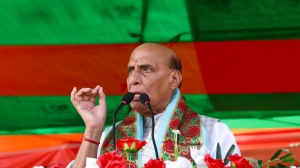More Romantic Than Fiction
Kishwar Desai’s account of Nargis’s extraordinary career and life is warmly personal, but it never gets voyeuristic

Darlingji: The True Love Story of Nargis and Sunil Dutt
Kishwar Desai
Harpercollins, Rs 395
Fifty years ago, after a 28-year-old Sunil Dutt rushed to save Nargis from a fire that broke out on the sets of Mother India, the two actors — who were playing mother and son in Mehboob Khan’s 1957 epic — went on to fall in love and eventually marry. It became the best known “true love story” of the film world, alluded to and echoed as recently as in Farah Khan’s Om Shanti Om in which Shah Rukh Khan (playing a junior actor) saves Deepika Padukone (playing the star female lead) from a circle of burning haystacks.
As Kishwar Desai remarks in Darlingji, an account of the extraordinary relationship of Nargis and Sunil Dutt, some sceptics assumed that it was star and showman Raj Kapoor who remained the great love of Nargis’s life, and that she married the less successful Sunil on the rebound; or that Sunil was marrying Nargis for her star status. Typical reactions to a choice made by a successful woman — and Nargis was, after all, the daughter and granddaughter of strong-willed women who made their own choices in matters of profession and relationships. Her grandmother, Dilipa Devi, a Brahmin widow at 13, went on to make a life as a gaanewali, living with a Muslim musician. Dilipa’s daughter Jaddanbai became a successful singer, entered the then new field of the cinema, and moved to Bombay where she began to make her own films. Soon Jaddanbai’s apartment in Chateau Marine on the famous Marine Drive became a hub for film people.
This was the family in which Nargis grew up, acquiring a carefully polished Bombay education even as she began an acting career, first as a child actor in her mother’s films and then, when she was 14, beginning her career as the female lead with Mehboob Khan’s Taqdeer.
And Darlingji is really the story of this intelligent, affectionate and altogether remarkable woman. In the course of her career, Nargis would play both the westernised woman and the conventional Bharatiya nari, but her iconic role would be Radha in Mother India. In her life after cinema, she would involve herself in meaningful social work, a tradition that Sunil would continue after her death (the Nargis Dutt Critical Care Centre at the Tata Memorial Hospital, Mumbai, a project of the Nargis Dutt Memorial Foundation, has benefited innumerable cancer patients). Desai’s book shows how, despite the sceptics, Nargis and Sunil Dutt went on to build a happy and lasting partnership that would endure the ups and downs they would face in their life together — including Sanjay’s drug habit and Nargis’s battle with cancer.
One of Desai’s main sources of information, and a most interesting one, is the Dutt family archive. For this is a chatty, communicative family, whose members are constantly writing not only to each other but also for themselves, especially as a record of memorable times — on postcards, letters, telegrams, diaries, baby books and more. Sunil and Nargis were writing little notes to each other all the time, addressing each other in different ways: often playfully, as “Pia” and “Hey There”; occasionally decorously, as “Dutt Sahib” and “Mama”; and once, days before their wedding, deeply hurt that she had not told him about her Filmfare Best Actress Award for Mother India, Sunil wrote a letter addressing her as “My Dear Padma Shri” and signing as “A Junior Artiste”.
The children continue the tradition of writing to communicate their feelings and preserve their memories. Nine-year-old Sanjay writes to his mother from his boarding school at Sanawar (“10 kisses to Yourself, papa, Anju, priya, rabbit, ringo and the chicks”); at 13, with painful observation and childlike accuracy, Priya records her mother’s illness in her diary.
Desai’s account of the Dutt love story, a warmly personal but never voyeuristic account, is enriched by these glimpses into the life of this close-knit family.







- 01
- 02
- 03
- 04
- 05
























